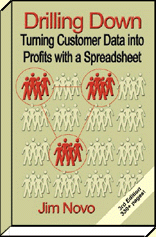Drilling Down Newsletter - October 2000
In this issue:
Drilling Down Site Revisions
New Article: Retention for Online Retailers
Questions from fellow Drillers
----------------------------------------------------------------------
Hi again Folks, Jim Novo here. Let's do some Drillin'!
----------------------------------------------------------------------
Drilling Down Site
==============
If you haven't been to the Drilling Down site lately, I have been
practicing what I preach - that is, the database and direct marketing
approach to doing business on the Web.
Although my expertise is on the "keeping customers" side of the
coin,
I have considerable experience in the "getting customers" biz
too, at
least from the direct marketing perspective. The site has gone
through a series of redesigns and the visitor to book sales ratio has
improved substantially. Dig this:
Weeks 1-4: 1 book sale per 500 visitors
Weeks 5-6: 1 book sale per 250 visitors
Weeks 7-8: 1 book sale per 100 visitors
How did I do this? You will get all the details in upcoming issues
of
this newsletter (Hint: The secret to keeping customers is getting the
right ones in the first place). So stay tuned! You might want
to
check out the Drilling Down site for clues if you haven't been there
for a while at the URL below:
https://www.jimnovo.com
----------------------------------------------------------------------
New Online Retention in Retailing Article
===============================
"Measuring Customer Retention in Online Retailing" is an article
I
wrote for the newsletter E-Tailer's Digest, loosely based on the
Hurdle Rate concept from the Drilling Down book. It shows you
how to use Hurdles to set up a "down and dirty" customer
retention
tracking method. I created this method at Home Shopping Network
and it works great for interactive environments. Check it out
at:
https://www.jimnovo.com/RetailCustomerRetention.htm
The only data you absolutely need is last activity date of the
customer. In retailing, you use purchase records; in pure
publishing,
you would use visits or page views. Got more data? Then you
can
track multiple indicators using the same method. Give it a try!
----------------------------------------------------------------------
Questions from fellow Drillers
======================
Got a couple of top shelf questions this issue from the more
experienced side of the customer retention biz. As I've said before,
the Drilling Down method works whatever size your business is. The
tools used are different, not the ideas driving their use. For
example, a small business may be using MS Excel or Access to keep
track of customers, and a large business would be using a CRM app or
rules-based engine. Doesn't matter, works for both. So, hey
little
guys, don't let the experts hog the spotlight, send your questions in!
These two questions from Drillers make a nice pair; they are related
features of customer buying behavior...
Q: Jim, I still don't get subsidy costs. I get the idea of
using
control groups, but how can a response to a marketing campaign
be bad?
A: Most response is good, of course. Subsidy costs refer to a
hidden cost primarily in best customer programs, where customers
have a high probability of making a purchase anyway. When you
promote to these people and offer discounts, you run the risk of
spending money and margin you did not have to spend to generate
the sale.
Think of it this way. You have a specific catalog purchase in mind.
The catalog mails to you pretty frequently (you're a best customer),
so you are waiting intently for a catalog to arrive to make the
purchase. It arrives, and low and behold, has a "20% off"
coupon
banner on it.
You go ahead with the planned purchase and spend 20% less than you
intended. That's a subsidy cost. Great for the customer, bad
for
business. The point is, you can measure these subsidy costs, and a
promotion has to cover the cost of them to be profitable. A better
alternative is to intentionally design the promotion to minimize
subsidy costs.
Q: Hi Jim. Is there any way to tell what the best length of
time is
to look for Halo Effects?
(If you have not read the Drilling Down book: Halo Effects occur
when people respond to a promotion outside of business tracking
procedures and are "not counted" as having responded. For
example, you send a discount and the customer loses it but
makes a purchase anyway because you "reminded" them of a
need they had).
A: Not really. You have to look for them at different time intervals
and discover the right length of time for your business and products.
In B2C, I would be very surprised if there were significant Halo
Effects after 60 days. In long sales cycle B2B, it could be 6
months,
maybe a year. Try looking at 30 days, then 60 days, then 90 days,
you'll see the Halo Effects slope off and approach zero. When they
approach zero, you should cut off your measurement.
Generally, the better the customer, the *less* the length of time will
be. If you are doing a one-time buyer conversion promotion, you
could
look out a bit longer.
----------------------------------------------------------------------
That's it for this month's edition of the Drilling Down newsletter.
If you like the newsletter, please forward it to a friend; the
subscription is free! Subscription instructions below.
Any comments on the newsletter (it is too long, too short, prefer
articles included in newsletter to a website link, etc.) please send
them right along to me. And don't forget, keep sending your customer
Valuation, Retention, Loyalty, and Defection questions to me.
'Til next time, keep Drilling Down!
Jim Novo
What would you like to do now?
Get
the book with Free customer scoring software at:
Booklocker.com
Amazon.com Barnes
& Noble.com
Find
Out Specifically What is in the Book
Learn Customer
Marketing Models and Metrics (site article
list)
|
